The Intel 6th Gen Skylake Review: Core i7-6700K and i5-6600K Tested
by Ian Cutress on August 5, 2015 8:00 AM ESTWhat You Can Buy: Linux Performance
Built around several freely available benchmarks for Linux, Linux-Bench is a project spearheaded by Patrick at ServeTheHome to streamline about a dozen of these tests in a single neat package run via a set of three commands using an Ubuntu 11.04 LiveCD. These tests include fluid dynamics used by NASA, ray-tracing, OpenSSL, molecular modeling, and a scalable data structure server for web deployments. We run Linux-Bench and have chosen to report a select few of the tests that rely on CPU and DRAM speed.
C-Ray: link
C-Ray is a simple ray-tracing program that focuses almost exclusively on processor performance rather than DRAM access. The test in Linux-Bench renders a heavy complex scene offering a large scalable scenario.
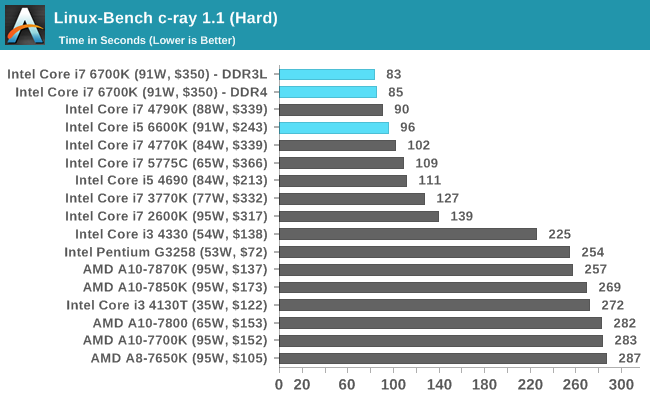
NAMD, Scalable Molecular Dynamics: link
Developed by the Theoretical and Computational Biophysics Group at the University of Illinois at Urbana-Champaign, NAMD is a set of parallel molecular dynamics codes for extreme parallelization up to and beyond 200,000 cores. The reference paper detailing NAMD has over 4000 citations, and our testing runs a small simulation where the calculation steps per unit time is the output vector.
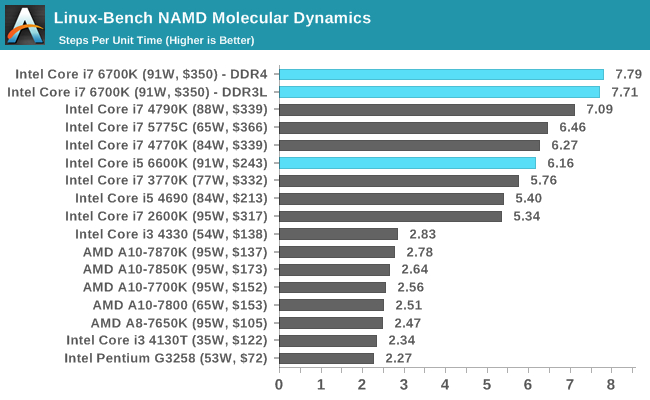
NPB, Fluid Dynamics: link
Aside from LINPACK, there are many other ways to benchmark supercomputers in terms of how effective they are for various types of mathematical processes. The NAS Parallel Benchmarks (NPB) are a set of small programs originally designed for NASA to test their supercomputers in terms of fluid dynamics simulations, useful for airflow reactions and design.
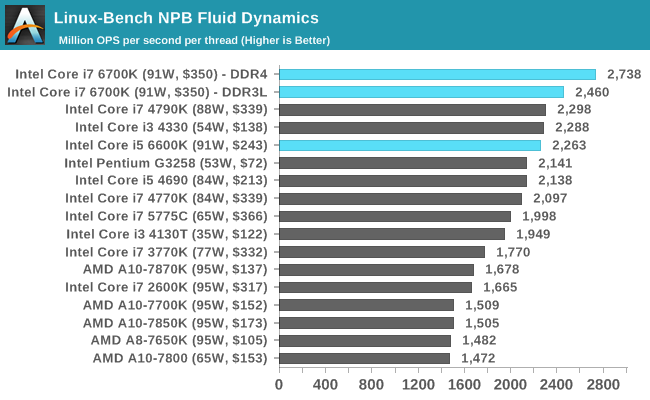
Redis: link
Many of the online applications rely on key-value caches and data structure servers to operate. Redis is an open-source, scalable web technology with a b developer base, but also relies heavily on memory bandwidth as well as CPU performance.
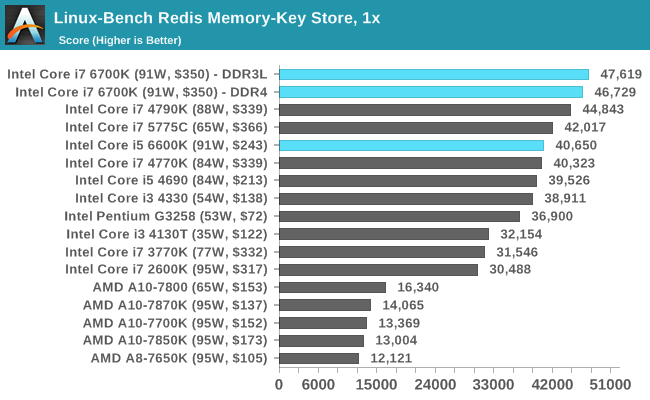
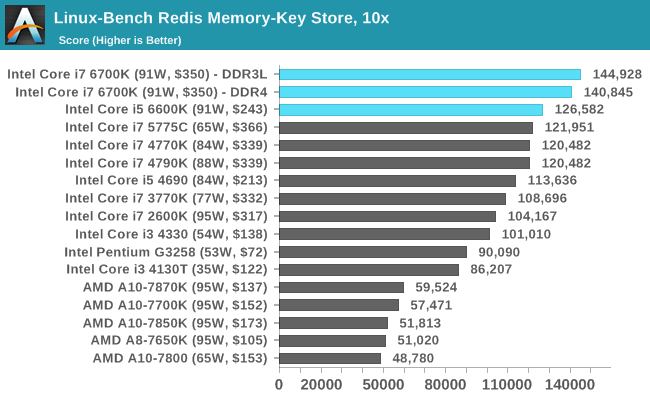
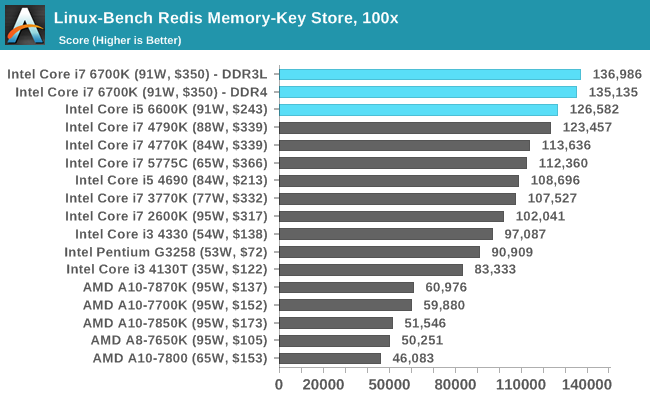










477 Comments
View All Comments
Sunburn74 - Wednesday, August 5, 2015 - link
Still not budging from my 2600K. There is no evidence of real world benefit of an PCIE drive compared to a sata drive. As for the CPUs, the 25% gain IS impressive considering the short time period it has been accomplished in but is just within the threshold of noticeability. Would prefer to wait till maybe 50% gain or when software really starts to take advantage of SSDs.Pneumothorax - Wednesday, August 5, 2015 - link
You're giving Intel too much slack here. Even the much maligned P4 generations had a 50% improvement in raw speed in 2 years. We've waited almost 4 years for only 25%. What's crazy is it cost Intel billions of R&D for it.heffeque - Wednesday, August 5, 2015 - link
25% in 4 yeas... but their iGPU now has more Dx12 Tier 3 support than nVidia and AMD.Nagorak - Wednesday, August 5, 2015 - link
Unfortunately, no serious gamer will ever use it.Bambooz - Wednesday, August 5, 2015 - link
"in my experience all computers are a bit unstable"in other words: you've been buying shitty components :)
kmmatney - Wednesday, August 5, 2015 - link
OK, come on! You bought a "K" cpu - it's meant to overclock - at least bump it up to 4.2-4.3 Ghz - it will run that without any voltage increase. In fact, most motherboards (mine included) seem to overvolt Devil's Canyon cpus, even at stock voltage. In fact, you can probably undervolt it, and overclock it at the same time, as Anandtech did here:You have a guide handed to you for overclocking this cpu:
http://www.anandtech.com/show/8227/devils-canyon-r...
My Z97 PC-Mate motherbard was setting my i5 4690K at 1.2V while at stock, which is higher than it needs - it can run at 4.5Ghz at that setting!
IUU - Saturday, August 8, 2015 - link
I agree with the upgrading part.But not quite with the 25% IPC increase. 25% is awesome.
Two important things:1. It carries the burden of a useless gpu. It could either consume
less energy or the same with more cores. At least then you would use the cpu
where possible for what it's meant to be used.
2. the 25 % increase is the "real" world performance. Unfortunately the "real" world is terribly
slow to take advantages of the improvement Intel introduces with the new instruction sets.
So while it's good to stay down to earth to the "real" world performance, it would be nice to have also a mention of the theoretical improvements of the cpu.
icebox - Wednesday, August 5, 2015 - link
I still don't see the reason to upgrade from a 2600k even though I really urge to upgrade my hardware :) I really don't care about integrated graphics and I'm pretty sure 80% buyers of i7 k parts don't either.There was no reason when ivy brought 5 percent, haswell another 10% and devil 5% more. Now it's a total of 25%. I want more from a total platform change - I moved from 755 to 1155 for a lot more than that. Mainly I want more than 16 PCI lanes, I understand they'll never give us more than 4 cores because xeon and E series.
euler007 - Wednesday, August 5, 2015 - link
Same here, I'm always waiting every generation upgrade my OC'ed 2500k, but I mainly use my home rig for gaming and these benchmarks give me no reason to upgrade. Maybe Skylake-E.moerg - Wednesday, August 5, 2015 - link
so DDR4 offers nothing in gaming?